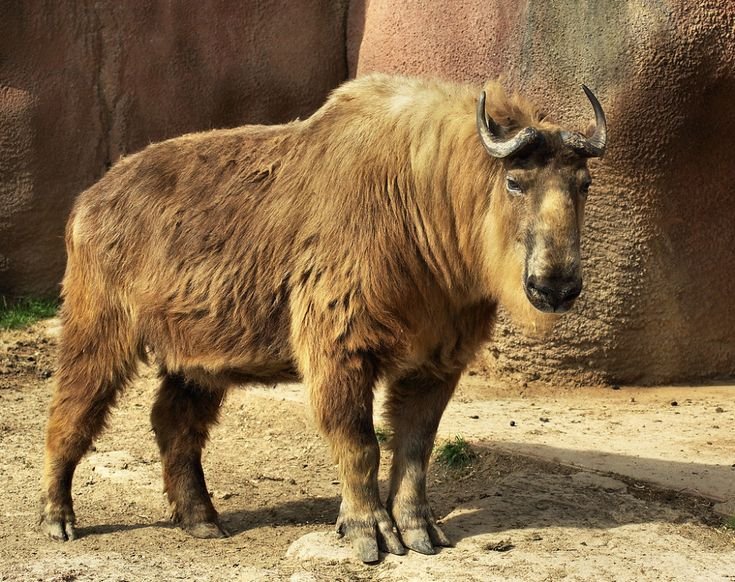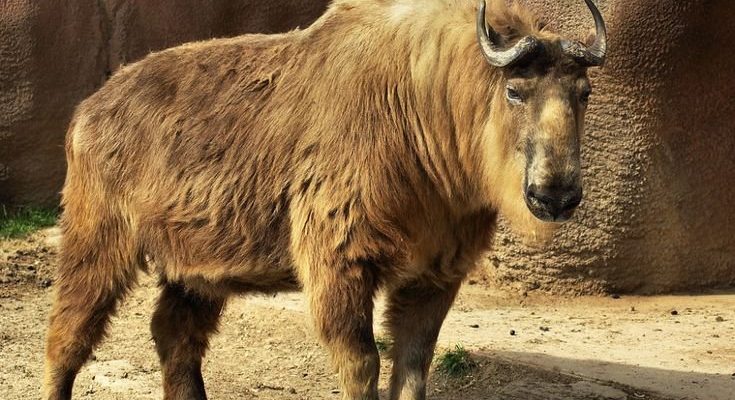
Let’s dive into the takin’s world—a place where evolution has sculpted a unique animal adapted to survive the rugged, high-altitude terrains of Asia. From its quirky features to its ancient lineage, the takin’s evolutionary history is like a puzzle that connects us to something much bigger in the grand narrative of life on Earth.
What Exactly Is a Takin?
Takin (pronounced “ta-kin”) belong to the Bovidae family, which is the same group that includes bison and domestic cattle. They are often found in the mountainous regions of countries like Bhutan, Nepal, and China. With their stocky builds, broad horns, and shaggy coats, they manage to stand out in any landscape, almost like nature’s own design experiment.
These animals are herbivorous and love munching on leaves, shrubs, and even the tough grasses that poke through snow in their alpine habitats. They are social animals, often found in small herds, which helps them protect themselves from predators like snow leopards. It’s pretty cool how their lifestyle has adapted to the harsh climates they call home!
The Takin’s Lineage: A Journey Through Time
To understand the takin’s story, we need to take a trip back in time—around 10 million years ago. The takin is believed to have diverged from other hoofed mammals during the Miocene epoch, a time when the Earth’s climate was changing and creating new habitats. Isn’t it crazy to think about how long these animals have been around?
Originally, takins roamed much of Asia, but over the eons, they’ve adapted and moved to fit into their mountainous niches. Their ancestors likely shared common traits with both goats and sheep, which hints at a fascinating evolutionary pathway. This shared lineage helps us understand how the takin evolved to thrive in its unique environment.
Physical Characteristics: Nature’s Unique Design
Now, let’s get into what makes the takin so special! First, their size is quite impressive. Adult takins can weigh between 200 to 800 pounds, which is massive compared to other mountain-dwelling animals. Their dense fur helps protect them from the cold, while their long legs and broad hooves provide balance and stability on rocky terrains.
One of the most striking features of the takin is its unusual face. They have large, rounded noses—perfect for sniffing out food hidden beneath layers of snow. It’s almost like they’re walking around with built-in snow gear! This distinctive appearance isn’t just for show; it plays a critical role in their survival.
Habitat and Distribution: Where Takin Roam
Takin generally thrive in the steep, rugged terrains of the eastern Himalayas. They love dense forests and valleys, where they can find plenty of food and shelter. Their habitat choice plays a significant role in their evolutionary success; they’ve adapted to high altitudes, which means they can breathe in thinner air and withstand the cold better than many other animals.
In terms of distribution, takins are primarily found in Bhutan and parts of western China. However, their habitats are increasingly threatened due to human activities and climate changes. This means that understanding takin’s evolutionary history is crucial for their conservation and ensuring these incredible creatures don’t vanish from the Earth.
Conservation Status: Protecting the Takin
You might be wondering why the evolution of the takin matters today. Well, the takin is classified as *Near Threatened* on the IUCN Red List, mainly due to habitat loss and hunting. It’s a reminder that even the most uniquely adapted species can be vulnerable.
Conservation efforts are underway to protect these majestic creatures and their habitats. Protecting takins isn’t just about saving one species; it also helps preserve the rich biodiversity of the ecosystems they inhabit. The takin’s evolutionary history serves as a testament to the importance of maintaining the delicate balance of life in these regions.
Interesting Facts About the Takin
Let’s wrap things up with some fun tidbits about the takin that might surprise you!
- Hairy Neighbors: Did you know that the takin is the national animal of Bhutan? It has significant cultural importance there.
- Strong Social Bonds: Takin herds can be pretty social, often consisting of family groups that stay together for protection and support.
- Unique Sounds: They communicate using a variety of sounds, from grunts to snorts, to convey their moods and alert each other to danger.
These quirky facts only scratch the surface of what makes the takin a standout species in the animal kingdom.
The takin’s evolutionary history is a fascinating glimpse into how life adapts to its environment. From their unique appearance and ancient lineage to their vital role in the ecosystem, these creatures remind us of the diversity of life on our planet. Protecting them matters—not just for their sake, but for the health of our entire world.
So, the next time you hear about the takin or see a picture, remember the incredible journey it has taken through time. It’s not just an animal; it’s a living piece of history, and its story is still being written. Let’s hope we can ensure it has a bright future ahead.

